Bathroom layouts: what you need to know
Struggling to plan your bathroom renovation? Here's a guide to some of the key factors you should consider before you get started

When you’re designing a kitchen, you’ve got the work triangle to guide where you position appliances and countertops. With bathrooms, you’ve got no such luxury. If you’re thinking about building a new bathroom or renovating, our guide covers the starting points.
Here’s how to ensure you end up with a bathroom that’s user friendly, functional and, most importantly, fits your needs.
Analyse your existing space
The first step is taking a good look at what you’ve currently got to work with – this is going to influence your plan for the new bathroom and, by extension, your budget.
Is there a window you can’t move? A shower that just can’t be relocated? Is there concrete beneath the floor?
Take stock of these things before moving onto the next step – plus, this is useful information to take to a designer.
Make a plan for your new bathroom
There are a few things to consider before you start your plan.
What are the things you can’t live without? Do you need lots of bench space? Storage for towels?
It’s also important to consider the people using the space.
If it’s just you, chances are you don’t need a large vanity.
On the other hand, if you have a family, you’ll need a larger vanity, bathtub, shower and towel rail.

Remember, don’t be limited by the adage that fixtures are expensive to move.
Moving your fixtures can be tricky, it's true.
However, the effort/expense required to, say, move a bath from one side of the room to the other may well fully unlock the potential for your space, upping its functionality and looks.
You can now put together a rough floor plan. It’s important to make sure the room flows and to avoid overlapping doors (shower and bathroom door, for example).
Balancing form and function
By now, you should have an idea of what your bathroom is going to look like, at least in terms of the major fixtures and fittings.
It’s time to move onto another important step – balancing form and function.
Here are some of the major considerations:
- Consider condensation – a powerful extractor fan is well worth the investment. However, a showerdome is an economical alternative and these are surprisingly effective.
- Don’t forget waterproofing – the last thing you want is structural damage thanks to poor tile work.
- Ensure your bathroom has a clear focal point. A copper basin or striking mirror captures the eye. Two such elements can make the space confusing.
- Think about the space as a whole. Is there a seamless flow throughout the bathroom? One of the best ways to create a cohesive space is to run the same tiles from the floor up the ceiling and into the shower.

Get advice from a professional – we can't stress this strongly enough!
Scheming and sketching is a great start but there’s really nothing like the guidance of a bathroom design expert.
By engaging with someone who knows what they’re doing, you’ll be able to rest easy knowing you have a space that fits your needs and is also appropriately waterproofed and functional.
No one ever said renovating a bathroom is easy, but you can make the process much less stressful with proper planning.
By choosing to work with an experienced bathroom designer, you’ll be able to make the task even simpler.
If you’re after more bathroom advice, take a look at some of our other articles.
Story by: Trendsideas
Home kitchen bathroom commercial design
Classic looks, contemporary efficiency
Diving into nature
Personality plus

